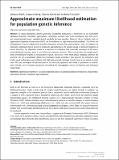Files in this item
Approximate maximum likelihood estimation for population genetic inference
Item metadata
| dc.contributor.author | Bertl, Johanna | |
| dc.contributor.author | Ewing, Gregory | |
| dc.contributor.author | Kosiol, Carolin | |
| dc.contributor.author | Futschik, Andreas | |
| dc.date.accessioned | 2018-11-02T00:48:24Z | |
| dc.date.available | 2018-11-02T00:48:24Z | |
| dc.date.issued | 2017-11-02 | |
| dc.identifier | 251552056 | |
| dc.identifier | c77f6634-aa94-4491-9f46-8d7a1209beb5 | |
| dc.identifier | 85035346880 | |
| dc.identifier | 000416100600001 | |
| dc.identifier.citation | Bertl , J , Ewing , G , Kosiol , C & Futschik , A 2017 , ' Approximate maximum likelihood estimation for population genetic inference ' , Statistical Applications in Genetics and Molecular Biology , vol. 16 , no. 5-6 , pp. 291-312 . https://doi.org/10.1515/sagmb-2017-0016 | en |
| dc.identifier.issn | 2194-6302 | |
| dc.identifier.other | crossref: 10.1515/sagmb-2017-0016 | |
| dc.identifier.uri | https://hdl.handle.net/10023/16376 | |
| dc.description | Funding: Austrian Science Fund (FWF-P24551) and by the Vienna Science and Technology Fund (WWTF) through project MA16-061 (CK). | en |
| dc.description.abstract | In many population genetic problems, parameter estimation is obstructed by an intractable likelihood function. Therefore, approximate estimation methods have been developed, and with growing computational power, sampling-based methods became popular. However, these methods such as Approximate Bayesian Computation (ABC) can be inefficient in high-dimensional problems. This led to the development of more sophisticated iterative estimation methods like particle filters. Here, we propose an alternative approach that is based on stochastic approximation. By moving along a simulated gradient or ascent direction, the algorithm produces a sequence of estimates that eventually converges to the maximum likelihood estimate, given a set of observed summary statistics. This strategy does not sample much from low-likelihood regions of the parameter space, and is fast, even when many summary statistics are involved. We put considerable efforts into providing tuning guidelines that improve the robustness and lead to good performance on problems with high-dimensional summary statistics and a low signal-to-noise ratio. We then investigate the performance of our resulting approach and study its properties in simulations. Finally, we re-estimate parameters describing the demographic history of Bornean and Sumatran orang-utans. | |
| dc.format.extent | 3189359 | |
| dc.language.iso | eng | |
| dc.relation.ispartof | Statistical Applications in Genetics and Molecular Biology | en |
| dc.subject | Approximate inference | en |
| dc.subject | Isolation-migration model | en |
| dc.subject | Maximum likelihood estimation | en |
| dc.subject | Orang-utans | en |
| dc.subject | Population genetics | en |
| dc.subject | Stochastic approximation | en |
| dc.subject | QA Mathematics | en |
| dc.subject | QH301 Biology | en |
| dc.subject | 3rd-DAS | en |
| dc.subject.lcc | QA | en |
| dc.subject.lcc | QH301 | en |
| dc.title | Approximate maximum likelihood estimation for population genetic inference | en |
| dc.type | Journal article | en |
| dc.contributor.institution | University of St Andrews. School of Biology | en |
| dc.contributor.institution | University of St Andrews. Centre for Biological Diversity | en |
| dc.identifier.doi | https://doi.org/10.1515/sagmb-2017-0016 | |
| dc.description.status | Peer reviewed | en |
| dc.date.embargoedUntil | 2018-11-02 |
This item appears in the following Collection(s)
Items in the St Andrews Research Repository are protected by copyright, with all rights reserved, unless otherwise indicated.

